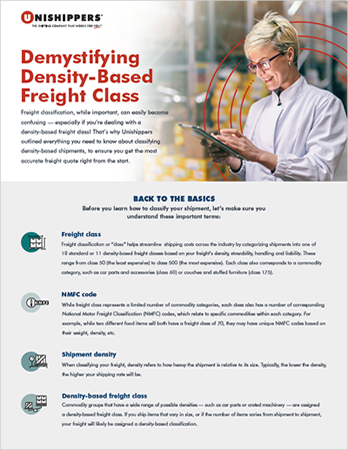Demystifying Density-Based Freight Class
Freight class is one of the main factors that will impact the cost of your business shipping. By correctly classifying your shipment, you can ensure you get the most accurate freight quote right from the beginning, while also avoiding costly delays and reclassification fees.
But freight classification, while important, can easily become confusing — especially if you’re dealing with a density-based freight class! Read on as Unishippers outlines everything you need to know about classifying your density-based freight shipments.
Speaking the Freight Shipping Lingo
Before you learn how to classify your shipment, it’s important to make sure you understand terms like freight class, NMFC code and density. Read on to get up to speed:
Freight class
The commodity classification or “class” system was created by the National Motor Freight Traffic Association (NMFTA) as a way to standardize shipping costs across the freight industry. Based on a number of factors that determine how cost-effective it is to transport your shipment — including its density, stowability, handling and liability — your freight will fall into one of 18 standard freight classes or 11 density-based freight classes. A freight class can be assigned to almost anything — from raw materials to finished products — and ranges from class 50 (the least expensive) to class 500 (the most expensive). Each class corresponds to a commodity category, such as car parts and accessories (class 60) or couches and stuffed furniture (class 175), to name just a few. Learn more about freight classification in this short video.
NMFC code
Every commodity has both a freight class and a coordinating National Motor Freight Classification (NMFC) code. While freight class represents a limited number of broad commodity categories, there are multiple NMFC codes for each class, which relate to specific commodities within each category. For example, while two different food items will both have a freight class of 70, they may have unique NMFC codes based on their weight, density, etc.
Density-based freight class
Many commodities are assigned a specific class, but for some, the class depends on the shipment’s density (how heavy a freight shipment is relative to its size). Typically, the lower the density, the higher — and more expensive — the freight class will be. Commodity groups that have a wide range of possible densities — such as car parts or crated machinery — are assigned a density-based freight class. If you ship items that vary in size, or if the number of items varies from shipment to shipment, your freight will likely be assigned a density-based classification.
Determining Density-Based Freight Class
Now that you understand the key terms, it’s time to walk through the classification process! To ensure you get the most accurate freight quote possible, it’s important to accurately calculate your shipment’s density to determine freight class. Follow these steps to make sure you get it right:
1. Find the correct NMFC code for your shipment
The first step in classifying your shipment is to determine if it falls under a density-based freight class. To do this, you must identify which NMFC code corresponds to the commodity you wish to ship. Once you know the NMFC code, you will be able to determine if your commodity is classed based on density.
There are a number of ways to find the correct NMFC code for your freight. Services such as ClassIT can assist you in determining the appropriate code and class for your freight. You can also find the correct codes for your shipment on the NMFTA website, in the official NMFC book or by contacting your local Unishippers office. Many times, the manufacturer of your goods can also help in determining the appropriate NMFC code.
2. Accurately weigh and measure your shipment
Once you know that your shipment has a density-based freight class, it’s time to determine its weight and measurements. This information will be used to determine the shipment’s density.
It’s important to note that you pay for the space your freight takes up on the truck, so be sure to carefully consider your packaging. Experiment with using different containers to find what fits your shipment best — you want to package it as tightly as possible without risking damage. You should also avoid pallet overhang, which works against your shipment’s density, among other reasons.
When determining the weight and size of your shipment, make sure to be precise and include any packaging in your calculations — even the pallet! Remember to round measurements to the nearest inch and weigh your shipment with an accurate shipping scale. Even small mistakes could result in incorrect classing, which can lead to costly delays and reclassification fees.
3. Calculate density
Next, you must calculate the density of your shipment. We know math can be a drag, but you can’t avoid this step! Use the following formula to calculate the density of your shipment:
L x W x H = cubic inches
Divide cubic inches by 1728 = cubic feet
Divide shipment’s weight by cubic feet = density
If you’re trying to avoid reliving your pre-algebra days, you can also use Unishippers’ handy freight density calculator. Unishippers customers can also simply enter the dimensions and weight of their shipment into myUnishippers™ to automatically calculate density.
4. Determine the freight class
Once you know your shipment’s density, you can then determine the appropriate freight class for your shipment. Then simply use this information when quoting and booking your shipment to ensure the most accurate freight quote possible!
Your Freight Class Coaches
While there are several aspects to navigating density-based freight classification, one thing you don’t have to worry about is navigating it by yourself. When you partner with Unishippers, you get access to a dedicated team of shipping experts to answer all your freight shipping questions. Contact us today to get started!




